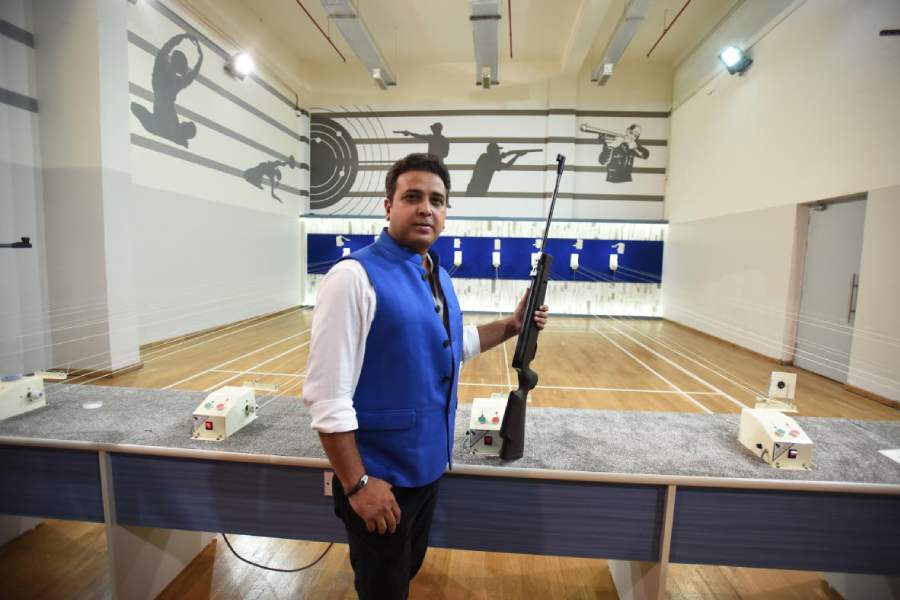At the 2023 Asian Games in Hangzhou, China, the Indian shooting contingent collected 22 medals, including seven golds. Among the champion shooters were quite a few who had been coached by Joydeep Karmakar, former Olympian and till 2023 national coach of the shooting team.
When I caught up with Karmakar in Calcutta, he was still on cloud nine; he’d expected a maximum of 18 medals. The Indian shooters had broken several world records and Asian Games records. Three of them — Sift Kaur Samra, Ashi Chouksey and Swapnil Kushale — had been coached by Karmakar until he quit. Samra, Chouksey and Kushale had had to shoot with a 50m rifle from three different positions, kneeling, prone and standing. This particular event is considered one of shooting’s toughest and India’s weakest link in the sport.
Karmakar was appointed India’s chief coach by the National Rifle Association of India (NRAI) — the governing body for the sport — in April 2022 after India’s rifle shooters failed at the Tokyo Olympics. Within a year of his appointment, shooters won 11 international medals and one of them qualified for the 2024 Paris Olympics. Nevertheless, Karmakar quit in June. Reasons cited were reportedly “backbiting” and “politics”.
The decision, however, didn’t sour his personal relations with the shooters, nor did it impact his engagement with the sport. During the Asian Games, he did running commentary for a TV channel and also posted live updates on X (formerly Twitter). It was not all news, but explanatory comments meant for non-experts. Karmakar tells me, “I want to popularise shooting among the common people in India. Why should all parents rush their children to cricket or football academies?”
With an aim to make the sport of shooting affordable, Karmakar started a training school in Calcutta. The first came up in 2015; now there are four. Mehuli Ghosh, who won a silver medal in 10m air rifle shooting in the recent Asian Games, also trained at his academy.
“Amazing performances of Indian shooters in recent times have encouraged many parents to enroll their children,” says Karmakar. Most children who enrol these days are from middle and lower-middle-class backgrounds, he notes.
In 1989, when Karmakar joined the North Calcutta Rifle Club in Belgachia for his basic training, shooting was considered more or less a hobby or a sport of the affluent. He was 10 then. Karmakar’s family was not very well off and he had to practise with borrowed guns for the next 13 years. There was a shortage of ammunition and the club infrastructure was quite poor. He reminisces, “It was an intense struggle for me in the formative years.”
Despite this he excelled at the national and international levels. In 2012, he qualified for the London Olympics and barely missed the bronze medal in 50m rifle (prone).
As Karmakar tells it, he decided to start his first academy out of a godown of the Sports Authority of India in Salt Lake, Calcutta, when someone in the audience at a felicitation programme for Olympians commented that most athletes play for personal gain and do little for the next generation. Karmakar’s academy eventually shifted to a school in New Town.
Karmakar charges nominal fees from talented shooters and even supports a few with arms and ammunition. He is aware that most of the traditional rifle clubs have remained as they were decades ago and their facilities are not robust enough.
Shooting nowadays needs sophisticated guns and, more importantly, electronic computer training systems. The new machines help shooters focus better and track movements of the head, arms and even breathing patterns.
The picture of shooting training is more or less the same across India. Former international shooters such as Karmakar, Gagan Narang (Hyderabad), Anjali Bhagwat (Pune) and Suma Shirur (Mumbai) have turned coaches, and many run their individual private academies.
In spite of several teething troubles, there are over 70,000 shooters registered at NRAI, according to Karmakar. There are another 15,000-20,000 waiting to get registered. He says, “Today, we have 18,000 shooters who compete in the national championship. Selection is done in three tiers.” This means, the competition has three rounds of qualification and elimination. The popularity has helped India improve its rank at the global level, and at the Asian Games India’s shooters were able to beat the Chinese, who are among the top.
But it will not do to rest on laurels. Besides, the Paris Olympics is around the corner. Karmakar stresses that the Olympics is a tougher arena. He says, “Indians will face stiff competition from German, Russian and American shooters, in addition to those from China. If our shooters perform the way they did in the Asian Games, 60 per cent of them will surely qualify for the Olympics finals.”











